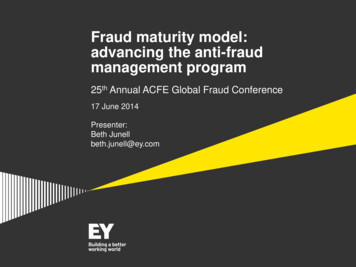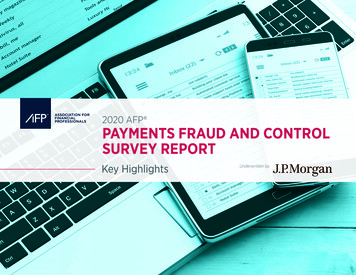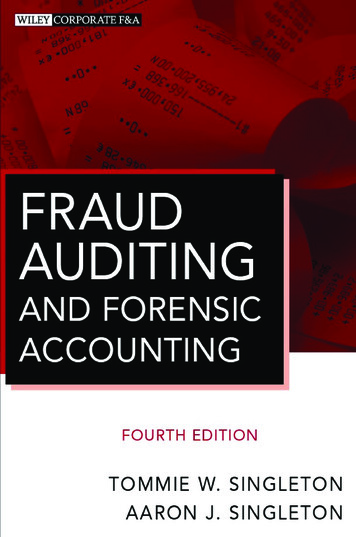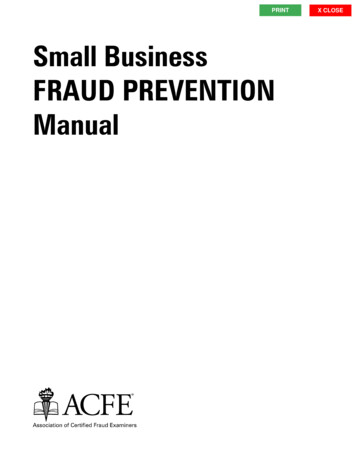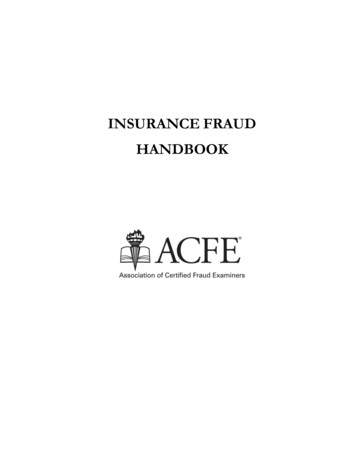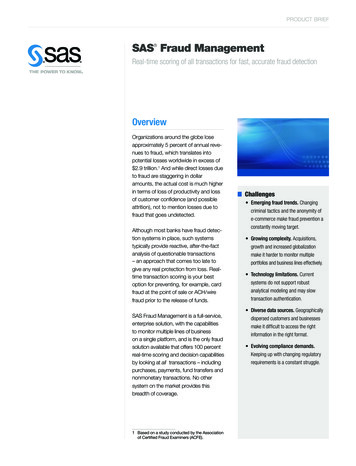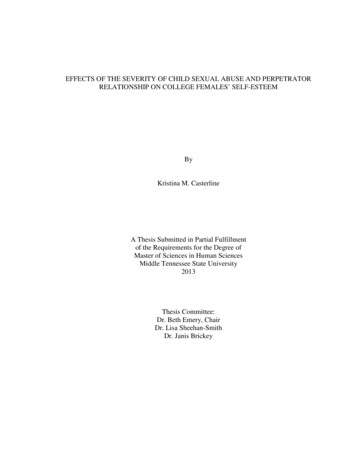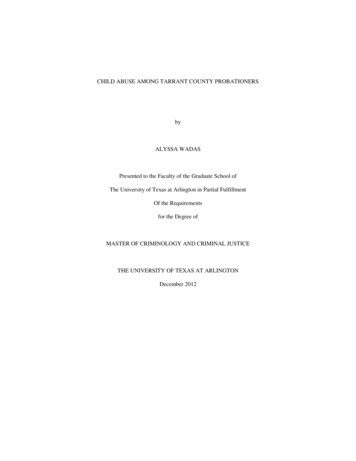
Transcription
Presenting a live 90-minute webinar with interactive Q&AHealthcare Fraud and AbuseLessons from 2012 Settlements, Court Rulings and Advisory Opinions, and Proactive Steps for 2013TUESDAY, JANUARY 22, 20131pm Eastern 12pm Central 11am Mountain 10am PacificToday’s faculty features:T. Jeffrey Fitzgerald, Partner, Polsinelli Shughart, DenverGregory S. Saikin, Counsel, Baker & Hostetler, HoustonJonathan N. Rosen, Shareholder, Polsinelli Shughart, Washington, D.C.The audio portion of the conference may be accessed via the telephone or by using your computer'sspeakers. Please refer to the instructions emailed to registrants for additional information. If youhave any questions, please contact Customer Service at 1-800-926-7926 ext. 10.
Sound QualityIf you are listening via your computer speakers, please note that the quality ofyour sound will vary depending on the speed and quality of your internetconnection.If the sound quality is not satisfactory and you are listening via your computerspeakers, you may listen via the phone: dial 1-866-320-7825 and enter your PINwhen prompted. Otherwise, please send us a chat or e-mailsound@straffordpub.com immediately so we can address the problem.If you dialed in and have any difficulties during the call, press *0 for assistance.Viewing QualityTo maximize your screen, press the F11 key on your keyboard. To exit full screen,press the F11 key again.
FOR LIVE EVENT ONLYFor CLE purposes, please let us know how many people are listening at yourlocation by completing each of the following steps: In the chat box, type (1) your company name and (2) the number ofattendees at your location Click the word balloon button to send
Strafford WebinarJanuary 22, 2013Fraud and Abuse: A Year in ReviewT. Jeffrey Fitzgerald, Esq.Polsinelli Shughart PCdirect: 303.583.8205jfitzgerald@polsinelli.comJonathan Rosen, Esq.Polsinelli Shughart PCdirect : 202.626.8359jnrosen@polsinelli.com
Settlement Trends—Pharma/Device Pharma settlements continue– Abbott paid 1.5B (off-label, sales conduct)– GlaxoSmithKine paid 3B (off label, sales conduct)– Boehringer paid 95M (off label)– Pfizer paid 55M (off label)– Victory Pharma paid 11.4M (sales conduct)– Sanofi paid 109M (sales conduct)– Amgen paid 762M (off label) Some medical device industry cases– Smith & Nephew paid 16.8M (sales conduct)– Stryker paid 15M (misbranding and sales conduct)– St. Jude paid 3.65M (warranty credits)– Orthofix paid 42M (sales conduct and medical necessity)5
Settlement Trends—Hospitals General increase in number of settlements involvinghospitals Inpatient/outpatient– Denver Health: 6M– Christus Spohn: 5M– Atlantic Health: 9M– Porton Plant Mease: 10.2M– Criminal resolution: WakeMed Health: 8M anddeferred prosecution agreement Kyphoplasty cases: 12M from at least 14 hospitals6
Settlement Trends—Hospitals Big systems– Tenet: 42.75M (inpatient rehab billing)– HCA: 16.5M (physician leases)– Mayo Clinic: 1.2M (billing issues) Billing and physician financial relationships– South Shore and Mount Vernon: 2.3M for j-code billing– Lenox Hill: 12M for Medicare outliers– Memorial: 1.3M for physician relationships Medical necessity and un-indicated care– EMH Medical Center: 3.9M and cardiologygroup: 550,000 for unnecessary angioplasties7
Settlement Trends—HIPAA Increase in cases and settlement amounts– BCBS Tenn.: 1.5M (loss of 57 hard drives)– A Phoenix cardiology practice: 100,000– South Shore Hospital: 750,000 (lost back-up tapes)– Alaska Medicaid: 1.7M (stolen USB drive)– Accretive Health: 2.5M (laptop theft)– Mass. Eye and Ear: 1.5M (laptop theft)– Anthem BC: 150,000 (lost data) First security rule settlement 500 : Hospice of No. Idaho: 50,000 for lack of computer security process8
Enforcement Trends—The Numbers Tell the Story OIG expects recoveries of 6.9 billion from fraud-relatedaudits and investigations in FY 2012.– Increase from 5.2 billion made in FY 2011 DOJ recovered 3 billion from health care False ClaimsAct cases Congress has increased funding to combat HCF– Affordable Care Act has increased funding to combatHCF by 40 million dollars in FY 2013– Aside from ACA funds, HHS and DOJ receive millionsmore in funding from Health Care Fraud and AbuseControl program9
Enforcement Trends—Unprecedented Collaboration Medicare Fraud Strike Force– AUSAs and DOJ Criminal Division attorneys, together with HHSand FBI agents– Netted criminal filings against 305 individuals and 181 convictionsin FY 2012 DOJ and HHS jointly conducted numerous national takedownsinvolving arrests of over hundreds of individuals, includingdoctors, nurses, health care executives and employees– Currently 9 USAOs host Strike Forces but will be expanding Health Care Fraud Prevention and Enforcement Action Teams“HEATs”– HEATs resemble Organized Crime Task Forces of the past Search warrants, ambush interviews UC operations,informants, videotape and audio recordings, asset seizuresand forfeitures10
HCF Enforcement Trends:Expansion of FCA Liability Anti-Kickback Liability– Confirms AKS violations are false claims and give rise to FCA liability (inaddition to AKS penalties)– Claims submitted in violation of the AKS automatically constitute false claimsfor purposes of the FCA.– New language of the AKS provides that “a person need not have actualknowledge or specific intent to commit a violation” of the AKSReverse False Claims– An overpayment means “* * * any funds that a person receives or retains undertitle XVIII * * * to which the person, after applicable reconciliation, is not entitledunder such title.” Expansion of Liability for Possession of Overpayments– Overpayments under Medicare/aid must be reported and returned within 60days of identification– Failure to timely report and return an overpayment exposes a provider toliability under the FCA11
Other Enforcement Trends Use of Non-HCF Criminal Statutes– Increase reliance on mail and wire fraud/health care fraud statutewith lower evidentiary burden Civil exclusion authority– In FY 2012, OIG excluded 3,131 individuals and entities fromparticipating in federal health care programs Increase from 2, 662 exclusions in FY 2011– Felony criminal convictions related to health care programs resultin a mandatory exclusion for a minimum of five years.– HHS-OIG has justified requesting longer exclusion periods, and insome cases has sought life long exclusions. Expansion of individual criminal liability– Responsible Corporate Officer Doctrine12
Noteworthy Cases—Existing Law Confirmed U.S. v. Krikheli, 2nd Cir.– Affirming the “one-purpose test” under the AKS Whitaker v. Health Net of California Inc., E.D. Cal.– No claim under HIPAA without actual damage U.S. ex rel. Banignan v. Organon USA Inc., D. Mass.– Standard “piercing corporate veil” law applies to FCA Foglia v. Renal Ventures Management, D.N.J.– State licence deficiency not a basis for FCA action U.S. ex rel. Williams v. Renal Care Group Inc., 6th Cir.– FCA does not apply to conditions of participationdeficiency– Also held that provider’s desire to maximizereimbursement was not basis for a FCA violation13
Noteworthy Cases U.S. v. Zhou, 9th Cir.– Defendant who improperly accessed PHI guilty underHIPAA even without knowing that actions were illegal Friedman v. Sebelius, D.C. Cir.– Upheld exclusion for executives who pled guilty underFDA’s responsible corporate officer doctrine Palomar Medical v. Sebelius, 9th Cir.– RAC auditor’s decision to reopen claims not subject tojudicial review, even if no good cause for reopening14
Cases That Differ From Settlements Average wholesale price litigation– Sandoz, Inc. v. State (Alabama) Reversed 78.4M judgment and held that stateMedicaid officials knew that AWP was inaccurate– Sandoz, Inc. v. Commonwealth, (Kentucky Ct. App.) Reversed 30M judgment on basis that Medicaidofficials knew how AWP worked Off-label marketing under the FDA Act– U.S. v. Caronia, 2nd Cir. Truthful, off-label marketing not prohibited by FDAAct and protected by 1st Amendment15
Other Developments OIG Civil Monetary Penalty actions– Four 1M cases (AKS cases)– 76% of CMP resolutions based upon self-disclosures– 57% of CMP resolutions based upon employment ofexcluded individuals CMS’ Stark Law self-disclosure protocol (Sept. 2010)– CMS reports to Congress that 148 submissions madeas of March 2012– As of Jan 1, 2013: 15 matters settled 5 settled for more than 100,000 6 settled for less than 50,00016
Other Developments HHS/DOJ letter to AHA (Sept. 24, 2012)– Concern that EHRs are being used “to game thesystem” and that EHRs permit documentation “to becut and pasted from a different record of the patient”– Concern over prompts and template information– No guidance, just a threat (or just politics) IG Levinson opined that 20-30% of all health carespending is waste and abuse (April 30, 2012 speech)17
Schedule for 2013 Regulations– Physician Payment Sunshine Act Mandatory disclosure and publishing of paymentsbetween manufacturers and physicians– Mandatory overpayment refund rule Implementing 60-day overpayment refund law– HITECH breach notification rule (released 1/17/13) Implementing duty to disclose HIPAA breaches– Mandatory compliance programs for providers Ruling in AHA v. Sebelius, D.D.C.– Calculation of overpayment in certain RAC audits Stark Law cases going to trial: Toumey and Halifax18
The Road Ahead—Predictions for 2013 High levels of OIG/DOJ enforcement and whistlebloweractivity will continue Continued rhetoric and attention to Medicare enrollment More and increasingly aggressive HIPAA enforcement Physician Sunshine reporting will have little widespreadimpact, but will be create material issues for a few Enforcement shifting from Pharma to hospitals andproviders– Medical device industry may side-step acute fraud andabuse attention Not in 2013, but beyond: Medicaid enforcement andenforcement based upon mandatory reporting19
Strafford WebinarJanuary 22, 2013Fraud and Abuse: A Year in ReviewT. Jeffrey Fitzgerald, Esq.Polsinelli Shughart PCdirect: 303.583.8205jfitzgerald@polsinelli.comJonathan Rosen, Esq.Polsinelli Shughart PCdirect : 202.626.8359jnrosen@polsinelli.com
Healthcare Compliance ProgramsJanuary 22, 2013Gregory S. SaikinCounsel, BakerHostetlerHealthcare Industry Teamgsaikin@bakerlaw.comT 713.646.1399
Roadmap Importance of effective compliance program Elements of an effective program Specific risk areas and other issues22
23
Corporate Criminal Liability Vicarious criminal liability Arthur Andersen prosecution DOJ Principles of Federal Prosecution24
Principles of Federal Prosecution1.Nature and seriousness of the offense;2.Pervasiveness of wrongdoing within company;3.Company’s history of similar misconduct;4.Corporation’s timely and voluntary disclosure of conduct;5.Existence and effectiveness of pre-existing compliance program;6.Corporation’s remedial actions, including efforts to implementan effective compliance program or to improve existing one;7.Collateral consequences that could result from indictment;8.Adequacy of prosecution of individuals; and9.Adequacy of civil or regulatory enforcement.U.S.A.M., §9-28.33025
“Effective” Compliance Program DOJ – “No Formulaic Requirements”–Paper v. Active Program?–Well-designed?–Effective in identifying/deterring misconduct? U.S. Sentencing Guidelines26
U.S. Sentencing Guideline §8B2.11.Establish Policies, Procedures and Controls2.Exercise Effective Compliance and Ethics Oversight3.Exercise Due Diligence to Avoid Delegation of Authority to Unethical Individuals4.Communicate and Educate Employees on Compliance and Ethics Programs5.Monitor and Audit Compliance and Ethics Programs for Effectiveness6.Ensure Consistent Enforcement and Discipline of Violations7.Respond Appropriately to Incidents and Take Steps to Prevent Future Incidents27
28
Benefits in Non-Criminal Context Avoid Payment Suspensions Consider self-disclosure to the OIG Avoid triple damages for amount of potential false claims Avoid Corporate Integrity Agreement Avoid Exclusion from Federal Healthcare programs29
OIG Guidance TimelineHospitals/HomeHealth 1998DME 1999PhysicianGroups 2000Ambulance 2003Pharma 2003Hospitals(Supplemental) 2005SNF 200830
OIG Seven Elements1.Implementing written policies, procedures and standards of conduct2.Designation of a compliance officer and compliance committee3.Developing open lines of communication4.Effective training and education5.Enforcing standards through well-publicized disciplinary guidelines6.Internal monitoring and auditing7.Response to detected offenses and developing corrective action31
Specific Risk AreasHospitals Integrity of use of electronic health recordsAnti-kickback statute (physician’s owned hospitals)Free transportationPharma Switching arrangementsOff-label marketingHome Health Medical necessity, intentional failure to dischargeKickbacks to referring physiciansFalsified nurse notes, missed visits32
Specific Risk AreasDME Billing with no CMNUpcodingWaiving co-paymentsSNF/Ambulance Swapping arrangementsPhysician Groups UnbundlingMisuse of NPIsPayments from DMEs/Home Health33
Programs should also address HIPAA Privacy and Security Rules Exclusion and debarment screening Responding to Government Investigations Anti-identity theft education and training34
HIPAA Massachusetts General Hospital Settles For 1 million“To avoid enforcement penalties, covered entities must ensure they are always incompliance with the HIPAA Privacy and Security Rules A robust compliance programincludes employee training, vigilant implementation of policies and procedures, regularinternal audits, and a prompt action plan to respond to incidents.”- U.S. Dep’t of Health and Human Services, Feb. 2011 Massachusetts Ear and Eye Associates, Inc. Settles for 1.5 million“In an age when health information is stored and transported on portable devicessuch as laptops, tablets, and mobile phones, special attention must be paid tosafeguarding the information held on these devices This enforcement actionemphasizes that compliance must be prioritized by management and implementedthroughout an organization, from top to bottom.”- U.S. Dep’t of Health and Human Services, Sept. 201235
ChicagoCincinnatiClevelandColumbusCosta MesaDenverHoustonLos AngelesNew YorkOrlandoWashington, DCwww.bakerlaw.com 2012 Baker & Hostetler LLP
-Criminal resolution: WakeMed Health: 8M and deferred prosecution agreement . 42.75M (inpatient rehab billing) -HCA: 16.5M (physician leases) -Mayo Clinic: 1.2M (billing issues) Billing and physician financial relationships -South Shore and Mount Vernon: 2.3M for j-code billing -Lenox Hill: 12M for Medicare outliers
